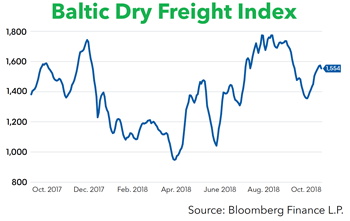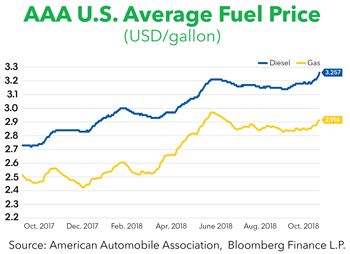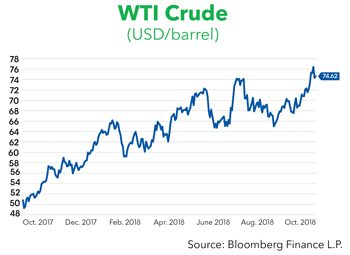 Atlantic:
Atlantic:
Hurricane Michael made landfall in the Florida Panhandle on Oct. 10 as a Category 4 storm. The system turned northeast after coming ashore, dropping rain on Alabama, Georgia, the Carolinas, and Virginia before an expected move east into the Atlantic around Oct. 12. Due to the Michael’s quick pace, significant navigation delays were not expected in the Gulf.
High water conditions in the Mississippi River continued to affect movements in the Upper Gulf region, limiting barge counts on southbound tows above New Orleans. Tows were reduced by a single string, or about five barges, resulting in average transit delays of approximately three days. Previous estimates called for a lifting of restrictions around Oct. 16, but a surge of fresh rain on the Upper Mississippi and Illinois Rivers were expected to prolong the restrictions.
 The Baton Rouge, La., river gauge was noted below the 30-foot flood stage, falling to 27.6 feet and holding on Oct. 10.
The Baton Rouge, La., river gauge was noted below the 30-foot flood stage, falling to 27.6 feet and holding on Oct. 10.
Bayou Sorrel Lock is closed through approximately Nov. 30 for refurbishment of the south lock gates, effectively closing the Port Allen Canal to commercial transport. Algiers Lock was available as an alternate route. With 46 tows in line to lock on Oct. 10, Algiers Lock waits were quoted at just under 45 hours.
Navigation is unavailable at Calcasieu Lock between 7:00 a.m. and 5:00 p.m., Monday through Thursday, due to an ongoing south chamber guide wall replacement project begun on July 30. Shippers put wait times at nearly 10 hours on Oct. 10, with 12 tows counted in the queue. The work is tentatively set to run through Dec. 1, 2019.
Bayou Boeuf Lock is scheduled to reopen on Oct. 15 after a round of planned repairs and maintenance. The Corps offered Bayou Chene as an alternate route.
 Industrial Lock delays were generally quoted up to six hours for the week, with occasional wait times spiking to 25 hours. The Colorado Floodgates reported multiple 12-25 hour delays, while waits were described as peaking at 7-9 hours at Brazos Lock’s western gate.
Industrial Lock delays were generally quoted up to six hours for the week, with occasional wait times spiking to 25 hours. The Colorado Floodgates reported multiple 12-25 hour delays, while waits were described as peaking at 7-9 hours at Brazos Lock’s western gate.
Mississippi River:
High-water operating conditions described on the Upper Mississippi River in recent reports were exacerbated by periods of heavy rainfall during the week, prompting a number of lock and bridge closures.
Locks 16-18 were reported closed on Oct. 10, and were expected to remain offline through Oct. 14 or 15. Locks 20-22 shut down starting on Oct. 8, with sources anticipating a restart no earlier than Oct. 23. Transit beneath the Louisiana Railroad Bridge (Upper River Mile 282) was unavailable as of Oct. 9, and some predicted a Lock 24 shutdown beginning on Oct. 11.
 Tow lengths continued to be reduced to nine barges from the usual 15 on southbound transits between St. Paul, Minn., and Prairie du Chien, Wisc., due to elevated river levels. The Corps limited barge counts to 12 from Prairie du Chien to St. Louis, also down from 15. Southbound tows were slashed by five barges between St. Louis and New Orleans.
Tow lengths continued to be reduced to nine barges from the usual 15 on southbound transits between St. Paul, Minn., and Prairie du Chien, Wisc., due to elevated river levels. The Corps limited barge counts to 12 from Prairie du Chien to St. Louis, also down from 15. Southbound tows were slashed by five barges between St. Louis and New Orleans.
Travel through the St. Louis harbor will be restricted to daylight hours only while area levels remain above the 25-foot mark. The National Weather Service put depths at 26.81 feet and rising fast on Oct. 10. The gauge is forecast to crest at a moderate-flood 35.5 feet on Oct. 14-15.
Mel Price Lock continued to see effects from an Oct. 2 accident at the site. Shippers said an assist boat was required in place for all of the week’s crossings, resulting in long delays. Waits were reported in a 16-34 hour range for the week.
Locks on the upper river are set to begin shutting down for the winter navigation season on Dec. 4. Several carriers announced Oct. 6-10 cutoffs for material headed above Dubuque, Iowa. Tons destined for ports between St. Louis and Dubuque were scheduled for release no later than Oct. 13-27, depending on carrier and destination.
Illinois River:
Heavy rains stymied transport along much of the Illinois River, with some describing navigational delays of up to 10 days. High water levels triggered the lowering of dams at both Peoria Lock and LaGrange Lock, allowing tows to pass without locking.
Ohio River:
Persistent high water conditions prompted the Corps to extend Newburgh Lock’s ongoing main chamber shutdown, sources said. The project, originally slated to conclude on Oct. 10-12, is now set to run through Oct. 26. Transit remained available one barge at a time via the lock’s secondary chamber. Sources said 28 tows were counted in line to lock on Oct. 10, pushing delays above 51 hours, a rise from 10 hours noted in the previous report.
Locking continued to be suspended at both Olmsted Lock and Lock 52 due to the elevated river levels, allowing boats to run both locks’ navigational passes. Lock 53, offline completely due to Olmsted’s recent successful start, is tentatively slated for retirement in the near term.
A planned R.C. Byrd Lock main chamber project remained on track to begin on Oct. 15. The work was rescheduled from the original Oct. 3 commencement due to high water in the area. Work is due to run through approximately Nov. 15. Tows will detour through the smaller auxiliary chamber, and delays are expected.
J.T. Meyers Lock transit was described in a 4-7 hour range for the week.
On the Tennessee River, sources quoted Kentucky Lock delays at nearly 20 hours on Oct. 9-10.